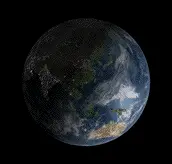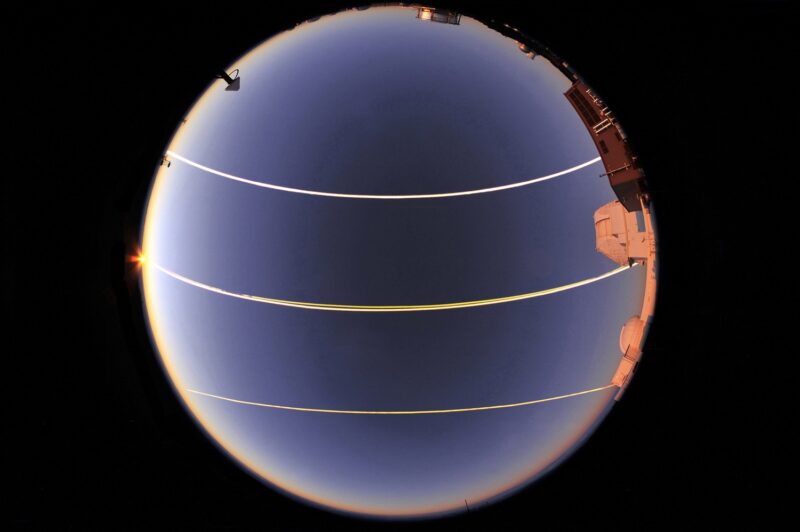In 2024, the December solstice falls at 9:21 UTC on December 21 (3:21 a.m. CST). Long nights, short days, for the Northern Hemisphere. Short nights, long days, for our friends south of the equator. No matter where you live on Earth’s globe, the solstice is your signal to celebrate seasonal change. EarthSky’s veteran stargazers Deborah Byrd and John Goss livestreamed on Thursday, December 19, about the solstice, the New Year’s Star and more. It was fun! Check out our solstice livestream here. This image, by the way, is from Ian Hennes in Medicine Hat, Alberta, Canada. It’s a solargram, created by shooting the sun’s in the sky between a June solstice and a December solstice. Thank you, Ian! Used with permission.
Do you have a personal solstice? Check out these personal solstices from members of the EarthSky community.
The December solstice marks the sun’s southernmost point in the sky, for all of Earth, for this year. It comes at 9:21 UTC (3:21 a.m. CST) on December 21. Though no world body has decreed it, we in the Northern Hemisphere will celebrate the first day of winter at this solstice. For us, it heralds the longest nights and shortest days of our year.
Meanwhile, people in the Southern Hemisphere will celebrate the first day of summer at this solstice. For them it marks the shortest nights and longest days.
After this solstice, the sun will begin moving northward in the sky again. It’s fun to track the northward movement of the sunsets on your horizon with pieces of tape on a window, or just by noticing the shifting sunset point from your favorite spot to observe.
What is a solstice?
The earliest people on Earth knew that the sun’s path across the sky, the length of daylight, and the location of the sunrise and sunset all shifted in a regular way throughout the year. They built monuments such as Stonehenge in England and Intihuatana at Machu Picchu in Peru to follow the sun’s yearly progress.
Today, we picture the solstice from the vantage point of space, and we know that the solstice is an astronomical event. It’s caused by the tilt of Earth’s axis and by its orbital motion around the sun.
Earth doesn’t orbit upright. Instead, it’s tilted on its axis by 23.5 degrees. Through the year, this tilt causes Earth’s Northern and Southern Hemispheres to trade places in receiving the sun’s light and warmth most directly. It’s this tilt, not our distance from the sun, that causes winter and summer.
In fact, we’re closest to – not farthest from – the sun at the turn of every new year. At the same time, we in the Northern Hemisphere are moving into winter. That’s because the Northern Hemisphere leans farthest away from the sun for the year around this time.

Why isn’t the earliest sunset on the shortest day?
The December solstice marks the shortest day of the year in the Northern Hemisphere and longest day in the Southern Hemisphere. But the earliest sunset – or earliest sunrise if you’re south of the equator – happens before the December solstice.
Instead of focusing on the time of sunset or sunrise, the key is in what is called true solar noon, which is the time of day that the sun reaches its highest point in its journey across your sky.
In early December, true solar noon comes nearly 10 minutes earlier by the clock than it does at the solstice around December 21. With true noon coming later on the solstice, so will the sunrise and sunset times.
It’s this discrepancy between clock time and sun time that causes the Northern Hemisphere’s earliest sunset and the Southern Hemisphere’s earliest sunrise to precede the December solstice.
The precise date of the earliest sunset (or earliest sunrise) depends on your latitude. But the sequence is always the same: earliest sunset, shortest day at the solstice, latest sunrise around early January. Or, for the Southern Hemisphere now, earliest sunrise, longest day at the solstice, latest sunset around early July.
And so the cycle continues.

The poles at the December solstice
At the December solstice, Earth is positioned so the sun stays below the North Pole’s horizon. Meanwhile, the sun is up 24 hours a day at the South Pole.
All locations south of the equator have day lengths greater than 12 hours.
All locations north of the equator have day lengths shorter than 12 hours.

Where should I look to see signs of the December solstice in nature?
Everywhere.
For all of Earth’s creatures, nothing is so fundamental as the length of daylight. After all, the sun is the ultimate source of all light and warmth on Earth.
In the Northern Hemisphere, you’ll notice late dawns and early sunsets, the low arc of the sun across the sky each day, and how low the sun appears in the sky at local noon. Look at your noontime shadow, too. Around the time of the December solstice, it’s your longest noontime shadow of the year.
In the Southern Hemisphere, it’s opposite. Dawn comes early, dusk comes late, the sun is high, and it’s your shortest noontime shadow of the year.

Bottom line: Happy solstice, y’all! The 2024 December solstice will fall early in the day on December 21. Shortest day for Northern Hemisphere. Great time to celebrate the seasons.
Visit EarthSky’s night sky guide
Read our previous article: Orion the Hunter, the most recognizable constellation
